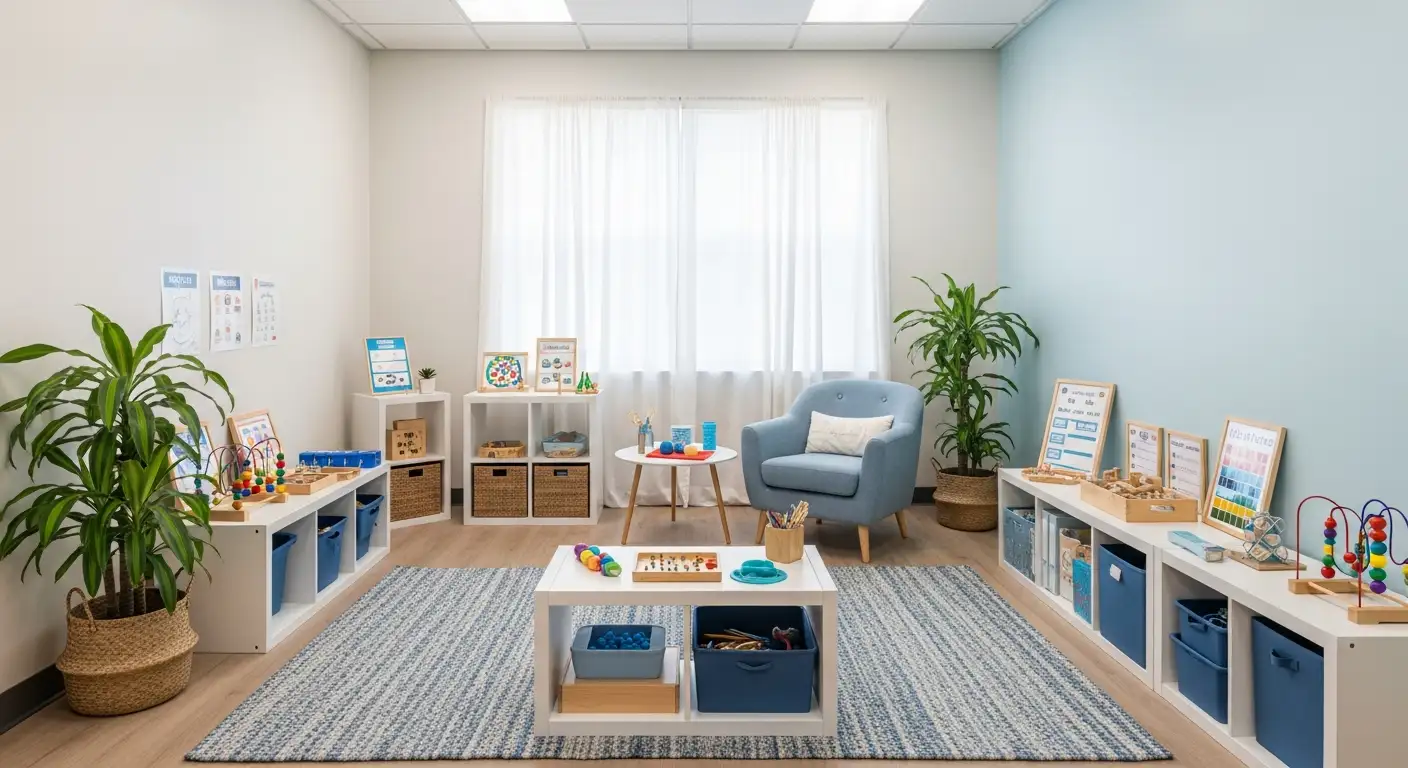Exploring Virtual Autism Therapy
Rise of Telehealth Direct Therapy
Telehealth direct therapy has emerged as a vital resource in providing autism therapy. It allows individuals with Autism Spectrum Disorder (ASD) to receive therapeutic interventions through online platforms and technology-based solutions. This accessibility has enabled a wider reach, ensuring that those in remote locations or with mobility challenges can still benefit from effective treatment options. Studies indicate that telehealth therapy has shown positive outcomes in teaching new skills, including language, adaptive, and social skills for individuals with ASD [1].

A growing number of families have embraced virtual therapy as a flexible alternative to traditional face-to-face sessions. This method alleviates barriers such as travel time and scheduling conflicts, making it easier for caregivers to secure consistent therapy for their children. The rise of telehealth has significantly impacted how autism therapy is delivered, making it more accessible and efficient.
Effectiveness of ABA-Based Interventions
Applied Behavior Analysis (ABA)-based interventions, when delivered virtually, continue to demonstrate effectiveness in addressing the needs of individuals with ASD. These interventions are structured to reinforce positive behaviors while reducing undesirable ones, helping individuals develop vital skills. Teletherapy adaptations of ABA methods can maintain their effectiveness by transitioning traditional techniques to virtual settings.
Research supports that many individuals with ASD benefit from receiving ABA interventions through telehealth. These interventions have proved adaptable and yield substantial benefits when delivered via teletherapy, even showing positive behavior changes and skill acquisitions over time. Such gains include the improvement of social and emotional skills through carefully designed virtual environments.
Intervention TypeKey BenefitsDelivery MethodABAReinforcement of desired behaviorsTelehealthTF-CBTEffective for emotional issuesTeletherapyVirtual RealityImprovement in social skillsVR platforms
The adaptability of various therapeutic approaches, including Trauma-Focused Cognitive Behavioral Therapy (TF-CBT), has also shown significant benefits when specifically tailored for online interactions with children diagnosed with ASD [2]. Virtual environments can enhance engagement levels and provide innovative methods to address challenges faced by individuals with autism, proving to be a promising frontier in autism therapy.
Continued exploration of virtual approaches, alongside traditional methods, offers parents and caregivers valuable resources to manage their child's autism effectively. The ongoing advancements in technology present an opportunity for tailored, flexible interventions that cater to the specific needs of individuals with ASD, ensuring they receive quality care that fits their unique situations. For further insights, explore resources on virtual autism assessment and autism with behavior problems.
Utilizing Telehealth Direct Therapy
Telehealth direct therapy has emerged as a vital tool for individuals with autism spectrum disorder (ASD). This approach has demonstrated positive outcomes in skill acquisition and has significantly modified the way therapy is delivered.
Positive Gains and Results
Telehealth direct therapy facilitates the teaching of new skills, including language, adaptive, and social skills. Therapy is effectively tailored to suit the remote setting, ensuring that services remain continuous and accessible. Research indicates that there has been notable improvement in independent responding when transitioning to telehealth formats. A retrospective analysis revealed that during the COVID-19 pandemic, participants maintained similar treatment hours per week and showed improvement across all targets [3].
MetricIn-Person TherapyTelehealth TherapyAverage Treatment Hours per Week1010Independent Responding ImprovementModerateSignificant
Caregiver Assistance Levels
The introduction of telehealth direct therapy has also impacted caregiver involvement levels. Caregivers play a crucial role in the therapy process, and the virtual format provides them with enhanced support. This new model fosters training opportunities, allowing caregivers to learn and apply strategies effectively within the home environment.
The individualized treatment plans in virtual ABA therapy emphasize positive reinforcement, prompting, and behavior management techniques, leading to improved outcomes for children with autism. Caregivers can actively participate in sessions, helping reinforce skills learned during therapy and promoting consistency across different settings.
The following table summarizes caregiver engagement during telehealth sessions:
Caregiver Engagement LevelDescriptionHighCaregivers participate actively in sessions, applying learned strategies.ModerateCaregivers assist in some activities but require guidance.LowLimited engagement due to challenges in remote therapy.
Through this model, caregivers receive vital support and resources which can enhance the effectiveness of interventions, ultimately benefiting their children’s development and skill acquisition. For further insights on the impact of virtual therapy, explore our article on virtual autism symptoms.
Transitioning to Virtual Therapy
The shift from traditional in-person therapy to virtual autism therapy has been significant, especially in light of recent global events. This section addresses the maintenance of treatment hours and the improvement in independent responding for children undergoing virtual therapy.
Maintenance of Treatment Hours
A retrospective analysis demonstrated that participants transitioning to telehealth direct therapy from in-person services during the COVID-19 pandemic were able to maintain similar treatment hours per week, ensuring consistent engagement with therapy. This continuity is crucial for effective therapy and allows for a seamless transition without compromising the progress made during in-person sessions.
Treatment ModalityAverage Weekly Treatment HoursIn-Person Therapy8 - 10 hoursVirtual Therapy8 - 10 hours
Both treatment modalities showed a similar range of treatment hours, indicating that virtual therapy can effectively replace traditional methods.
Improvement in Independent Responding
In addition to maintaining treatment hours, improvements in independent responding have also been observed. Children in virtual therapy settings demonstrated significant gains in correct independent responses across various targets. Research indicates that virtual therapy has yielded comparable effectiveness to traditional settings in promoting skill acquisition.
MeasureVirtual TherapyIn-Person TherapyCorrect Independent Responses (%)75%74%
The slight increase in correct independent responses in virtual therapy settings highlights its potential as a viable alternative for children with Autism Spectrum Disorders (ASD). Furthermore, both parents and clinicians have increasingly preferred virtual visits due to their convenience, accessibility, and flexibility, thereby supporting the effectiveness of virtual autism therapy [4].
Overall, the transition to virtual therapy has shown promising outcomes regarding the maintenance of treatment hours and improvements in independent functioning, making it a valuable option for addressing the needs of children with ASD during these challenging times. For more insights into the effectiveness of virtual approaches, explore our article on virtual autism symptoms.
Virtual Reality Therapy for Autism
Virtual reality (VR) therapy is becoming a transformative approach in the field of autism treatment. By utilizing immersive experiences, therapists can enhance traditional therapeutic methods, providing individuals with autism the opportunity to learn and practice new skills in controlled virtual environments.
XRHealth's Innovative Approach
XRHealth is at the forefront of this innovation, offering a new type of online therapy for autism spectrum disorder. Their platform combines evidence-based therapies with advanced virtual reality technology to deliver exceptional care [5]. Through tailored VR therapy sessions, licensed clinicians can address various needs, including physical therapy, occupational therapy, and behavioral health services. This comprehensive approach allows therapists to leverage the capabilities of VR technology, creating engaging therapeutic experiences suitable for individuals on the autism spectrum.
Within VR environments, users can interact with scenarios that simulate real-life situations. This immersive setting helps them practice social skills, manage emotions, and enhance communication abilities, all in a safe atmosphere.
Therapeutic Potential of VR in Autism Therapy
Research indicates significant improvements in essential skills for individuals with autism when using VR therapy. Studies have shown that VR-based interventions can effectively enhance communication abilities, social skills, daily living skills, and emotion regulation skills. Specifically, virtual reality and augmented reality have demonstrated moderate to strong effectiveness in addressing particular challenges faced by those with autism spectrum disorder.
Furthermore, a 2021 study published in the Journal of Autism and Developmental Disorders supports the effectiveness of virtual ABA therapy. The findings suggest that virtual sessions can be as beneficial as traditional in-person therapy, proving that this innovative method holds substantial promise for individuals with ASD [1].
Overall, the integration of virtual reality into autism therapy represents a significant advancement in treatment options. As professionals continue to explore this frontier, VR therapy is poised to impact the therapeutic landscape positively, bringing new hope and improved skills to those living with autism.
Benefits of Virtual ABA Therapy
In recent years, virtual ABA therapy has emerged as a promising alternative to traditional in-person sessions. It offers significant advantages that can make a real difference for families navigating autism.
Accessibility and Cost-Effectiveness
One of the primary benefits of virtual ABA therapy is its increased accessibility. Families can now receive therapy regardless of geographical location or physical mobility challenges. This convenience proves vital for those in remote areas or with limited transportation options. According to Autism Behavioral Wellness, virtual therapy is particularly cost-effective for families who may find it difficult to attend in-person sessions, reducing travel costs and time constraints.
BenefitDescriptionIncreased AccessibilityTherapy can be accessed from home, making it easier for families.Cost-EffectivenessOffers a more affordable option without transportation expenses.Geographical FlexibilitySuitable for individuals in remote or underserved areas.
Additionally, virtual therapy has gained traction as a viable treatment option. A 2021 study published in the Journal of Autism and Developmental Disorders found that virtual ABA therapy can be as effective as in-person therapy.
Individualized Treatment Plans
Virtual ABA therapy excels in providing personalized support through individualized treatment plans. Each plan is designed to accommodate the unique needs of the child. Therapists incorporate various techniques such as prompts, positive reinforcement, and behavior management strategies tailored for each case, which plays a pivotal role in encouraging positive behaviors and reducing negative ones [6].
Therapists can continuously adapt these plans based on the child's progress and specific needs. This flexibility ensures that the therapy remains relevant and effective, fostering better outcomes for the child's development. For more information on parent training goals, check out our article on aba parent training goals examples.
Key FeaturesDescriptionTailored PlansEach treatment plan is customized for the individual child's requirements.Behavior ManagementUtilizes various strategies to promote positive changes in behavior.Continuous AdaptationPlans evolve based on the child's ongoing progress and needs.
The focus on individualized treatment within virtual settings enhances the effectiveness of autism interventions, providing robust support to children and their caregivers alike. Through virtual therapy, families can access comprehensive resources while fostering an environment conducive to growth and learning.
Impact of Virtual Therapy
The impact of virtual autism therapy is significant, particularly in terms of skill acquisition and addressing the specific needs of individuals with autism spectrum disorder (ASD).
Effectiveness in Skill Acquisition
Virtual Applied Behavior Analysis (ABA) therapy provides personalized support through individualized treatment plans tailored to each child’s unique requirements. This customized approach emphasizes prompts, positive reinforcement, and behavior management techniques, leading to more effective outcomes for individuals with autism.
Recent studies indicate that VR-based interventions have shown moderate to strong effectiveness in enhancing various skills, including communication abilities, social skills, daily living skills, and emotion regulation skills. These technologies offer targeted solutions, significantly improving the challenges faced by individuals with ASD.
Skill AreaImprovement Rate (%)Communication Abilities60Social Skills70Daily Living Skills65Emotion Regulation Skills75
Addressing Specific Needs
Virtual autism therapy has emerged as an innovative method that leverages technology to cater to the specific needs of individuals with ASD. It enables therapists to deliver personalized interventions such as social skills training, communication therapy, and behavior management strategies through video conferencing and specialized software. This approach helps to address the unique challenges and goals of individuals, regardless of their geographical location.
Moreover, virtual therapy programs exhibit higher completion rates, attendance rates, and frequency of treatment visits compared to traditional in-person methods, highlighting their effectiveness in delivering behavioral health interventions [4].
MetricVirtual TherapyIn-Person TherapyCompletion Rates (%)8570Attendance Rates (%)9075Number of Treatment Visits12 average8 average
These advancements showcase the potential of virtual autism therapy to enhance the lives of individuals with autism by providing flexible, effective solutions that cater to their needs.









